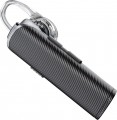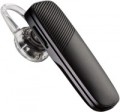Range
The maximum distance from the headset to the signal source at which it can be used normally.
Note that this indicator is stated for optimal conditions; the actual communication range is often lower than the claimed one due to obstacles in the signal path and extraneous interference. However, the minimum range for Bluetooth accessories is actually
10 m, which in fact, usually, gives at least 5 – 6 m — and this is quite enough for comfortable use. There are also more "long-range" solutions, with a range of
up to 50 m or
even more. However, it is worth remembering that Bluetooth is a two-way communication, and the range claimed in the specs must be supported not only by the headset itself, but also by the device with which it is used.
Also note that a long range means not only the ability to communicate over a long distance, but also a good ability to work through obstacles such as thick walls. Therefore, a powerful Bluetooth device may be necessary even at a short distance — if there are obstacles at this distance.
Features
—
Multipoint. A feature of Bluetooth devices (see "Connection") that allows them to connect to multiple signal sources at the same time. Thanks to this, it is possible, for example, to use one headset both for answering phone calls and for chatting via Skype on a laptop. However, some mobile phones (mostly devices with the simplest functionality, not smartphones) do not support this feature and are not able to work with a headset connected simultaneously to another gadget.
—
Noise reduction. A feature that allows the headset microphone to "hear" only the necessary sounds (primarily speech) and filter out extraneous noise. The specific implementation of noise reduction can be different: some models provide an additional microphone that tracks noise and "cancels" it from the final signal, while others use purely software methods of sound cleaning. Anyway, such filtering significantly improves the audibility for the person at the other end of the line.
— Volume control. Own volume control built right into the device. Adjusting the sound in this way is usually more convenient than reaching into your pocket for your phone, changing settings on a laptop, etc. On the other hand, an additional control affects the compactness. Therefore, among Bluetooth headsets (see "Device") this feature is not always provided; but for speakerphones that do not have special restrictions on dimensions, it is alm
...ost mandatory.
— Auto volume control. Automatically adjust the volume at which the device plays sound. Adjustment is usually carried out according to the level of ambient noise: in a quiet environment, the volume is reduced so as not to create discomfort, and in a noisy environment it is increased, ensuring normal hearing. Many models use the same microphone for auto-adjustment as noise canceling systems (see above), although this feature is not necessarily combined with noise canceling.
— Voice dialing. The ability to dial numbers by voice command, voiced into the microphone of the device. This feature is especially useful if you need to make a call, but reaching for the phone is undesirable or impossible — for example, when driving. Therefore, voice dialing is extremely popular in car kits (see "Device"), models without this feature are extremely rare. This feature is also supported by numerous Bluetooth headsets. However to use voice dialing, it must also be supported by the gadget to which the headset or car kit is connected; however, modern smartphones and tablets have no problems with this, difficulties can arise only with some models of classic mobile phones (non-smartphones). But language support in voice dialing needs to be specified separately: English is available in almost any model, but other languages are not so common.
— Microphone mute. The ability to temporarily mute the device's microphone — usually by pressing a special button. This will be useful in case you need to say something "to the side" and you do not want the person on the line to hear you. Note that the built-in microphone mute function is available in almost all mobile phones, as well as in most programs for voice communication like Skype. However, using the button on the headset is often more convenient than going into the settings of a smartphone or computer.
— A2DP profile. A Bluetooth connection feature (see "Connection") that allows stereo sound to be transmitted. A2DP support is by definition available on Bluetooth accessories that support stereo (see Audio). At the same time, this profile can also be provided in conventional one-ear headsets — it allows such a headset to normally reproduce sound originally recorded in stereo format (for example, podcasts or audio books), and is also used when headphones are connected (see below). Anyway, to use A2DP, it must be provided in both the accessory and the main device. Therefore, if you, for example, are looking for a headset for a simple phone that does not have A2DP, you can choose a model without this feature.
— AVRCP profile. Bluetooth connection feature (see "Connection"), which turns the accessory into a wireless remote control. To be more precise, we are talking primarily about managing audio and video players: start / pause playback, switch tracks, rewind, etc. At the same time, this feature can be provided even in Bluetooth headsets for one ear, which are not intended for music at all — for example, with such a headset you can control the music played from your smartphone through a portable speaker. Of course, AVRCP can only be used if both Bluetooth devices support it.
— NFC. NFC is a short-range wireless communication technology with a range of up to 10 cm. In Bluetooth accessories, the main purpose of this technology is to speed up the connection: instead of digging through the settings, just bring the accessory with NFC to a gadget that has the same chip (smartphone, tablet, etc.) and confirm the connection; and many gadgets allow you to configure and automatically connect when approached. There are other options for using NFC, but in this case they are practically not found.
— Display. Own display, which can show various service information: battery charge, volume level, connection indicator, etc. The specific capabilities of such a screen may vary depending on the type of accessory (see "Device"). However, most models with this feature are car kits — they can provide a fairly large screen with extensive information options, such as showing the number of an incoming or outgoing call. In headsets, screens are extremely rare: after all, most of the time the device is on the ear, out of the user's field of vision.
— Headphone jack. It's for connecting traditional headphones to the device. Most often, such a connector is a standard 3.5 mm mini-Jack, used in most modern headphones, which provides very extensive connection options. But the purpose and capabilities of this connector depend on the type of accessory (see "Device"). So, most models with this feature are speakerphones, and you can connect both regular headphones without a microphone, and wired headsets with their own microphone; both of them are used mainly to ensure the privacy of the conversation. But Bluetooth headsets are usually only compatible with headphones without microphones, and such headphones are used mainly for listening to music — you can talk privately on the phone using the headset itself.Battery capacity
The capacity of the battery installed in the device (see "Power").
Theoretically, a higher battery capacity allows you to work longer on one charge. At the same time, the actual battery life will also depend on the power consumption of the device, and it is determined by a number of technical specs. Therefore, it is better to evaluate battery life not by battery capacity, but by directly claimed operating time (see below). It makes sense to use this parameter if the operating time is not specified; at the same time, it makes sense to make conclusions only if devices similar in specs differ in capacity — for example, 60 and 110 mAh.
Replaceable ear hooks
You can
change the ear hook that is used to attach the Bluetooth headset to the ear. This feature allows you to adjust the device to the features of the auricle, which is especially necessary for people with a non-standard size or shape of the ears. Usually spare temples are included in the package, and if necessary, they can be purchased separately.

